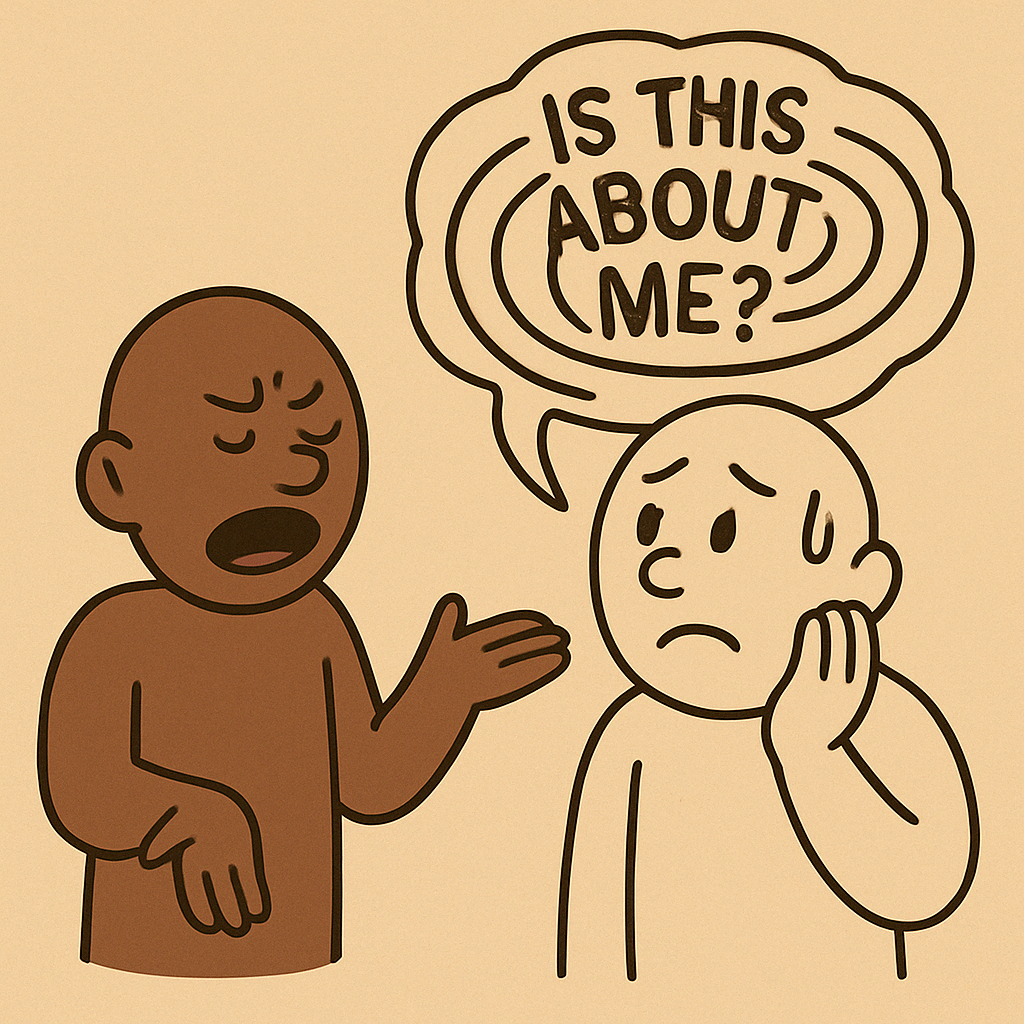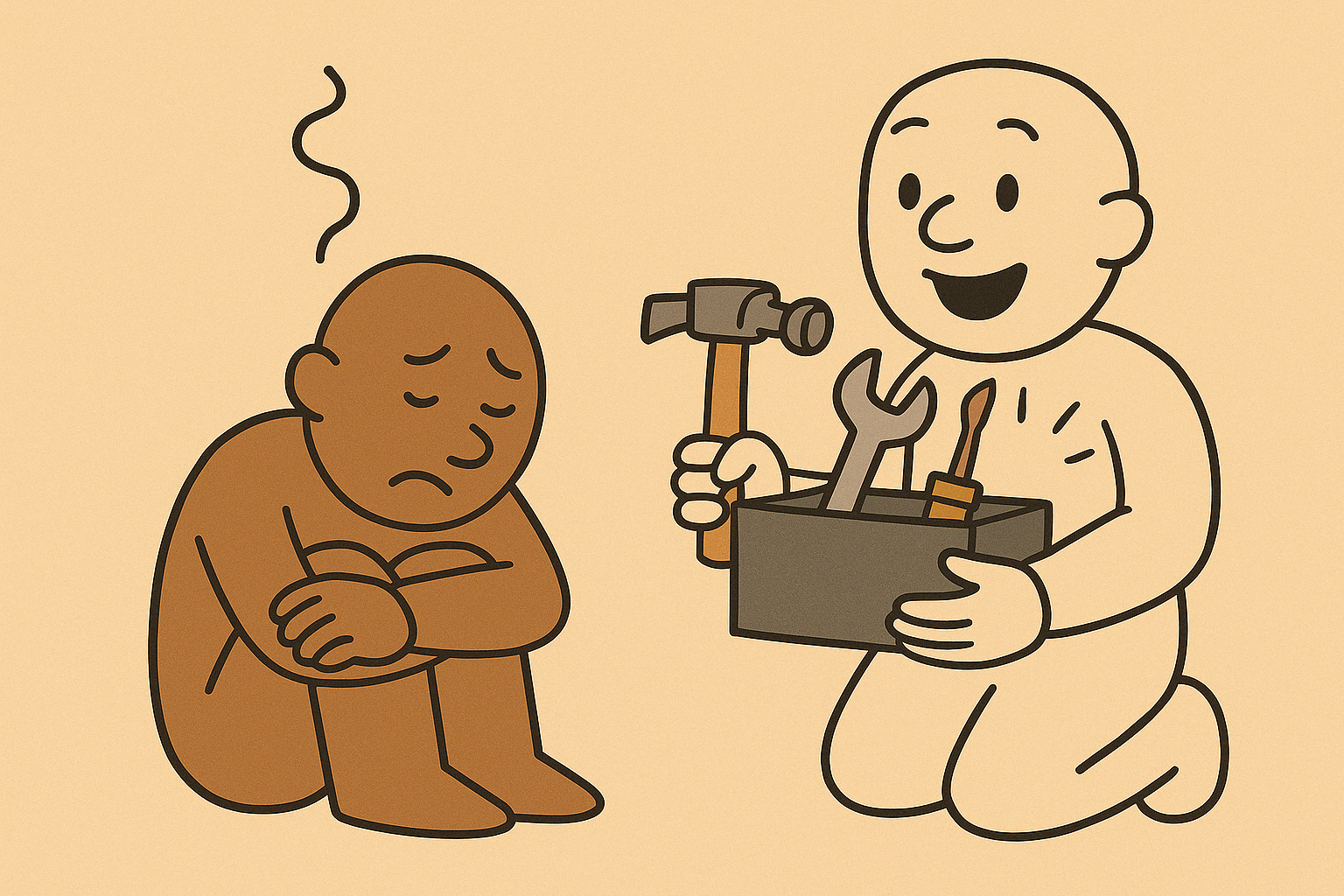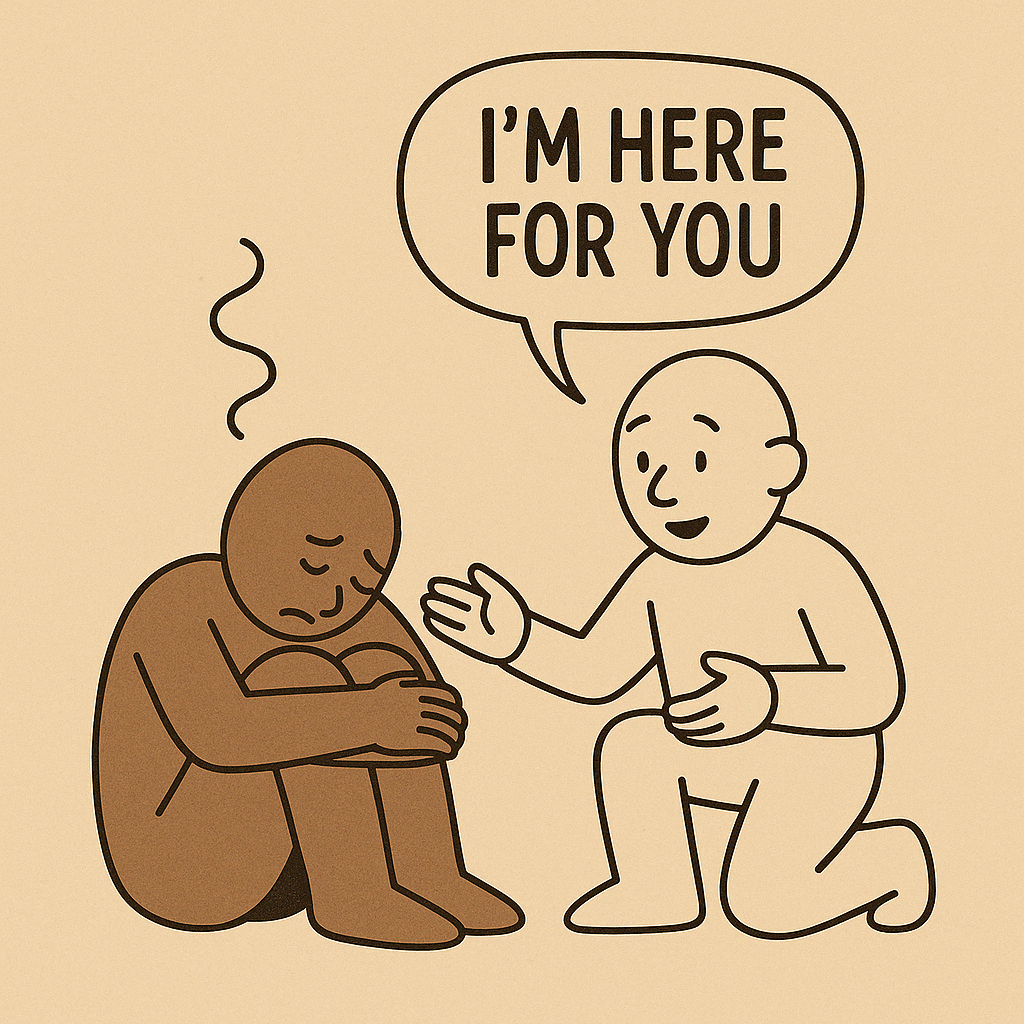Why You're Still Bad at Comforting People (And What Might Be Going On Beneath the Surface)
⚠️ Need a heads-up? This post takes about 7 minutes to read silently (or 13-14 aloud).
So you read my original post, 7 Reasons Why You Suck at Comforting Others (ouch, I know), and you’re back for more? Or maybe you didn’t read it, and you just instinctively know this is an area where you flounder. Either way, welcome. You’re in good company!
Let’s be real, comforting someone who’s struggling sounds simple in theory, but in practice, it’s a social/emotional obstacle course. Even when we have good intentions, it can still go sideways. Like, “wait... why are they more upset now?” sideways.
Here’s the thing: comforting others isn’t just about saying the “right” thing. It’s about understanding the emotional terrain you’re stepping into, and how your own wiring impacts the way you show up for others.
So if you’re ready to dive deeper and figure out why your attempts at comfort sometimes land with a thud (or worse, a flinch) this post is for you.
1. The Neurodivergent Relating Struggle
If you’re neurodivergent (hey ADHDers, Autistics, PDAers—you’re my people!), you might be familiar with this one: you try to comfort someone by telling them about a similar thing you went through. You’re trying to relate, but what it sounds like is, “Let’s make this about me now!”
This is called “parallel relating,” and it’s a very normal neurodivergent way to connect. But to someone who just wants to feel seen in their experience, it can come off as invalidating or self-centered, even if that was the last thing you meant.
Tip: Relating is beautiful, but anchor it in their feelings first. Try: “That sounds so hard. I’ve been through something similar, would it help if I shared?”
2. Emotional Overload: When Feeling Too Much Means Doing Too Little
Sometimes we care so much that our own nervous system starts to short-circuit. If someone’s breaking down, and you’re starting to sweat and panic on the inside, you might end up doing the emotional equivalent of dropping your phone and yelling “NOPE!”
Emotional flooding can lead to freezing up, offering a quick fix to end the pain (yours and theirs), or ghosting altogether.
Tip: If you’re overwhelmed, say so, gently. Try, “I’m here, and I care, but I need a minute to regulate and process. Can we just sit together for a moment while I ground myself?”
3. Taking It Personally: The Curse of Internalizing Someone’s Pain
Here’s a big one: someone tells you they’re upset, and your brain immediately goes, “Is this about me? Did I cause this? Am I being judged right now??”
I see this a lot with couples in counseling. One partner totally internalizes the other one’s feelings as a personal attack, the other doesn’t get heard or validated. Suddenly, instead of being present with their pain, you’re internally defending yourself or spiraling. This turns their moment into your emotional experience, and that never goes well.
And I will admit that even for myself, it is sometimes hard not to fall into this trap. When you allow the mental and emotional flood to happen, it keeps you from actually hearing that person and accepting their experience as their own, even at what feels like your expense. If anyone else was making your friend or partner feel that way, wouldn’t you have a different response? THIS is what you need to channel!
Tip: This is where a little self-awareness comes in handy. Their feelings are not a commentary on you. Let them have their feelings without making it about your role in them. Try: “Thank you for trusting me with that. I’m here to listen.”
4. The Fix-It Reflex (When You Skip Asking What They Need)
Someone shares something vulnerable and your first instinct is: “I can help! Here’s how we fix this!”
It’s natural. We don’t like watching people we care about suffer, and solving the problem feels like a kindness. But helping or advising when you haven’t been asked to can feel like an insult or a commentary on the other person a la “you clearly don’t know what you're doing, I’ll show you, I am superior to you here.”
More often than not, people don’t want a solution, they want support. And trying to fix too quickly can come across like their pain is a problem to be solved rather than an experience to be honored.
What’s missing in these moments is a simple pause. Before jumping in with ideas, ask what they need.
“Do you want to vent, or would you like help thinking through this?”
“What kind of support would feel good to you right now?”
This one question (or two actually) shifts the whole dynamic. It puts the power back in their hands and gives you a map for how to actually show up well. It may feel weird, even silly, when you first start this, but I’d put money on the positive impact it can make!
Tip: You don’t have to guess what kind of comfort they need. Just ask. It’s not weird, it’s actually incredibly validating.
5. Sidebar: The Enneagram Might Be the Missing Puzzle Piece
Now, if there’s anything I’ve learned in my years of studying the Enneagram (which is… a lot, let’s be honest), it’s that different types not only feel differently, but also express and receive comfort in wildly different ways.
Some people want solutions (hello, Type 3!), others want deep emotional connection, even wallowing at times (Type 4, I see you), and some would rather do literally anything else than talk about feelings (looking at you, Type 8 and Type 5!).
If you know your own Enneagram type, consider how it might shape the way you show up when someone is upset. Are you a fixer? A feeler? A freezer? And if you know their type, it might give you a little roadmap for what kind of support will actually land with them.
Psst… not all comfort styles are created equal.
If you read this section about how your Enneagram type might be getting in the way, and thought, “Oof… that’s me,” then you’re in the right place.
Come hang out in the Enneagram Greenhouse. I’ve got a free test, type-by-type deep dives, and all the insights you didn’t know you needed (until now). Your type might just explain why you keep throwing pep talks at people who just needed a hug. What a perfect segue into our next point!
6. Physical Comfort—When (and If) It’s Right
Let’s not forget nonverbal comfort. Sometimes words fall flat, and what someone really needs is physical presence. A hug. A hand on the shoulder. Sitting nearby and offering quiet companionship.
But please hear this: only when it’s appropriate.
Comfort through touch should be consent-based and relationship-informed. Just because you’re a hugger doesn’t mean the person crying in front of you wants to be pulled into a full-body hug.
Tip: If you’re unsure, ask: “Would a hug help right now?” “Can I hold your hand as I listen?” or just “Do you want me to sit with you?” That simple gesture of respect is a form of comfort.
7. Telling Someone Their Feelings Are “Wrong” (Even If You Don’t Mean To)
Let me paint you a picture. Someone’s upset (sad, anxious, overwhelmed) and you, in all your well-meaning glory, swoop in with:
“Don’t be sad!”
“There’s nothing to worry about!”
“It’s not really like that.”
Now, in your head, you’re trying to be helpful. You want them to feel better. You’re trying to offer perspective or calm them down. But what they hear might be:
“Your feelings are wrong.”
“You’re overreacting.”
“You’re seeing this wrong and need to feel something else.”
Oops.
This kind of response, while well-intentioned, often leads to shame, shutdown, or discouragement. It tells the person that their emotional reality is invalid, and that you know better than they do about what they’re experiencing. And let me just say, nothing kills comfort faster than being emotionally corrected when you're already down.
It’s not that we can’t offer perspective (sometimes that’s helpful!), but timing and tone matter. Offering validation before perspective is the secret sauce.
Tip: Swap “Don’t feel that way” with “I can see how that would make you feel that way.” Or try “That makes sense given what you’ve been through. I’m here for you.”
*Remember, feelings don’t need to be corrected in the moment, just felt. And when we honor someone’s emotional experience instead of trying to edit it, we create space for genuine comfort.
8. Cultural and Family Influences: The “Get Over It” Script
If you grew up in a household or culture where emotional expression was frowned upon (or worse, punished) you might’ve internalized the message that feelings are problems to manage or suppress. So when someone else is upset, your gut instinct might be to say:
“You’ve got to let it go.”
“Don’t dwell on it.”
“Move on.”
This isn’t about cruelty. It’s about conditioning. Many of us were never taught how to sit with our own discomfort, let alone someone else’s.
Tip: Let people feel what they feel. Honor their timeline. Sometimes the most comforting thing you can do is sit quietly beside someone and say, “Take all the time you need.”
9. The Emotional Invalidators in Disguise
Let’s talk about sneaky invalidation. You know, those shiny, well-meaning statements that feel positive but actually… kinda suck?
“Everything happens for a reason.”
“At least it’s not worse.”
“Look on the bright side!”
Look. I get it. You’re trying to help. You want to bring hope into a hard moment. But what these kinds of statements often do is slap a motivational poster on someone’s pain and walk away. And listen, if they wanted Pinterest platitudes, they’d go scroll through an “inspiration” board, not open up about their emotional struggles with you.
Statements like these are the comfort equivalent of handing someone a balloon after their house just burned down. It might look hopeful, but it doesn’t meet them where they are. If they are in the thick of it, trying to blast them off on your rocketship of toxic positivity does nothing but shut them down.
These “bright side” bombs tend to bypass the actual feeling part of emotional support. They skip past the discomfort, the grief, the anger, and jump straight to forced perspective. And while reframing can be helpful, the timing matters. If someone is deep in their struggle, they don’t want to be dismissed or emotionally rushed.
Tip: Resist the urge to be the cheerleader right away. Offer empathy first, save the hope and perspective for later. A better start is: “That’s really hard. I hate that you’re going through this.”
*Oftentimes, if you can sit in the muck with them long enough to get it out, they begin to rally on their own, then you can bring your hopefulness to the launchpad!
10. Is Your “Comforting” Actually for Them or You?
Oof. This one’s personal.
Here’s the thing: discomfort is, well, uncomfortable. When someone you love is upset, your own nervous system might start freaking out too. So what do we do? We scramble to shut down their feelings, not because we don’t care, but because we don’t want to feel the secondhand emotional heat. And we call it comfort.
Sometimes we try to make people feel better not because it’s what they need, but because we can’t stand the discomfort of watching them hurt. So we rush to fix, we change the subject, we get uncomfortably cheerful. And all of that? It’s more about soothing ourselves than supporting them. But real comfort isn’t about making you feel better. It’s about making them feel safe.
Tip: Get curious. Ask yourself, “Who is this for? Am I comforting them for their sake, or mine?” Then breathe through the discomfort and stay present. They don’t need your solution, they need your steadiness. Be an even keel on their stormy seas.
11. The Spiritual Bypass (aka “Holy Ghosting” Someone’s Pain)
As a person of faith, I say this with love: sometimes prayer and Scripture are offered at the wrong time and in the wrong way.
“God won’t give you more than you can handle.” - Let’s unpack that for a second. First off, um, what? Life absolutely gives us more than we can handle sometimes. It’s why community, therapy, and yes, faith, exist in the first place. Telling someone this can feel more like a challenge than comfort. Like, “Well if you’re falling apart, maybe your faith just isn’t strong enough.” Yikes.
“Just give it to God.” - sure, it is beautiful in theory. But when someone’s drowning in grief, trauma, or anxiety, this can feel like handing them a spiritual to-do list instead of sitting beside them in the storm.
“I’ll pray for you,” often followed by walking away.
These can unintentionally communicate: “Stop feeling what you’re feeling.” They can make someone feel like they’re failing spiritually if they’re struggling emotionally. It can also feel like “if you were a better Christian, you wouldn’t be this upset”. Gee… thanks.
Tip: If faith is a shared language, offer it with compassion and consent. Instead of offering prayer over presence, offer it as part of presence. Try: “I’m here for you. Would it be okay if I prayed with you?” Let your faith be a balm, not a bypass.
Final Thoughts: Comfort Doesn’t Have to Be Perfect
You don’t have to be a counselor. You don’t need a degree in feelings. You just need to show up, ask, listen, and hold space. It’s not about being profound, it’s about being present.
So next time someone you love is struggling, don’t panic. Don’t fix. Don’t “at least” them to death.
Just be there.
Validate.
Ask.
And if you mess it up, be humble and say so, then try again.
That, my friend, is what real comfort looks like.




